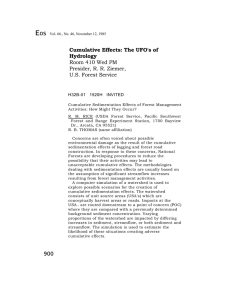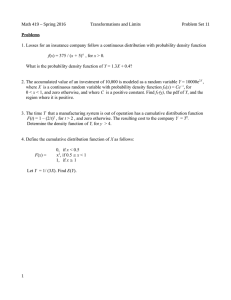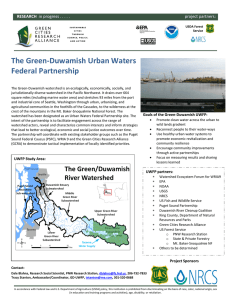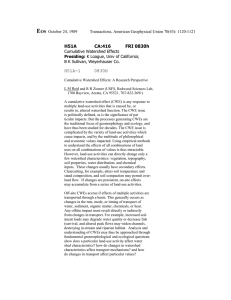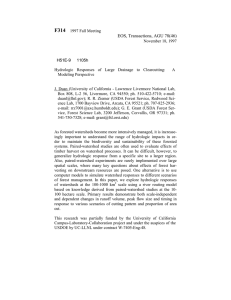Landscape Scale Effects of Fuel Management Cumulative Effects Analysis? Cumulative Watershed Effects
advertisement
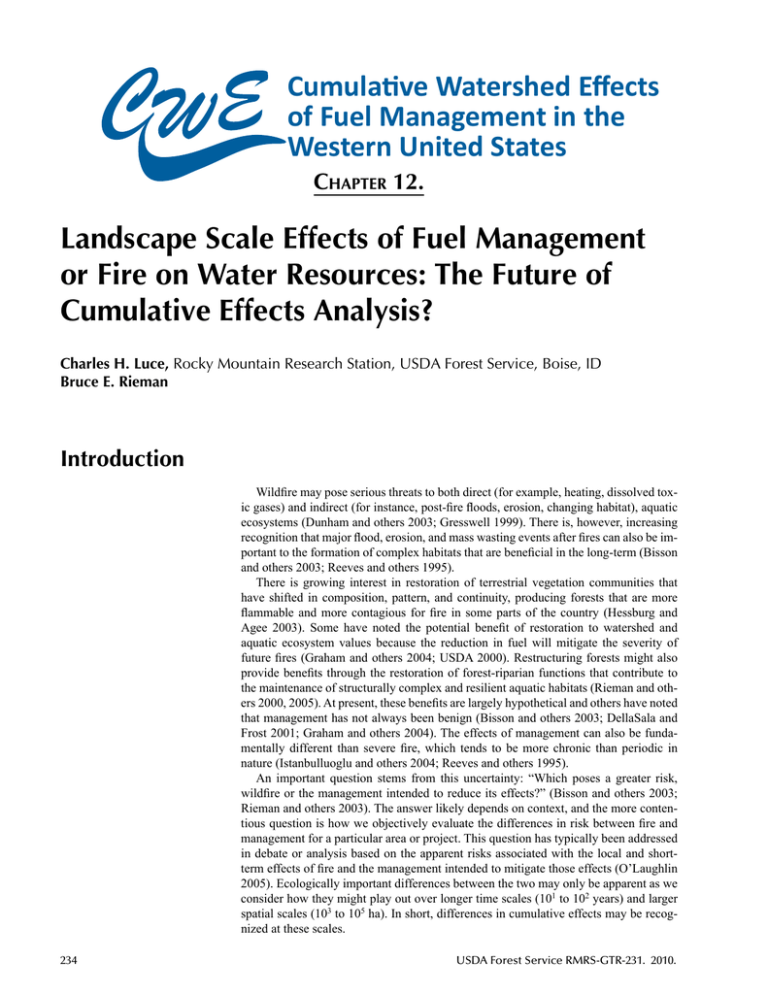
Cumulative Watershed Effects of Fuel Management in the Western United States Chapter 12. Landscape Scale Effects of Fuel Management or Fire on Water Resources: The Future of Cumulative Effects Analysis? Charles H. Luce, Rocky Mountain Research Station, USDA Forest Service, Boise, ID Bruce E. Rieman Introduction Wildfire may pose serious threats to both direct (for example, heating, dissolved toxic gases) and indirect (for instance, post-fire floods, erosion, changing habitat), aquatic ecosystems (Dunham and others 2003; Gresswell 1999). There is, however, increasing recognition that major flood, erosion, and mass wasting events after fires can also be important to the formation of complex habitats that are beneficial in the long-term (Bisson and others 2003; Reeves and others 1995). There is growing interest in restoration of terrestrial vegetation communities that have shifted in composition, pattern, and continuity, producing forests that are more flammable and more contagious for fire in some parts of the country (Hessburg and Agee 2003). Some have noted the potential benefit of restoration to watershed and aquatic ecosystem values because the reduction in fuel will mitigate the severity of future fires (Graham and others 2004; USDA 2000). Restructuring forests might also provide benefits through the restoration of forest-riparian functions that contribute to the maintenance of structurally complex and resilient aquatic habitats (Rieman and others 2000, 2005). At present, these benefits are largely hypothetical and others have noted that management has not always been benign (Bisson and others 2003; DellaSala and Frost 2001; Graham and others 2004). The effects of management can also be fundamentally different than severe fire, which tends to be more chronic than periodic in nature (Istanbulluoglu and others 2004; Reeves and others 1995). An important question stems from this uncertainty: “Which poses a greater risk, wildfire or the management intended to reduce its effects?” (Bisson and others 2003; Rieman and others 2003). The answer likely depends on context, and the more contentious question is how we objectively evaluate the differences in risk between fire and management for a particular area or project. This question has typically been addressed in debate or analysis based on the apparent risks associated with the local and shortterm effects of fire and the management intended to mitigate those effects (O’Laughlin 2005). Ecologically important differences between the two may only be apparent as we consider how they might play out over longer time scales (101 to 102 years) and larger spatial scales (103 to 105 ha). In short, differences in cumulative effects may be recognized at these scales. 234 USDA Forest Service RMRS-GTR-231. 2010. Charles H. Luce, Bruce E. Rieman Cumulative Watershed Effects of Fuel Management in the Western United States How the relative cumulative effects of fire and management alternatives are analyzed is important. Analyses that compare only the absolute sediment or thermal loadings accumulated through a watershed will be incomplete and potentially misleading. The literature on cumulative effects has already noted that non-linear and synergistic effects of activities may be important as well (Dunne and others 2001; MacDonald 2000; Reid 1993; Sonntag and others 1987). In particular, we argue that synergistic effects related to synchrony over several watersheds or sub-populations are an important cumulative effect consideration for comparing the effects of fire versus fuel management. Cumulative Watershed Effects By strict definition, cumulative effects are expected to manifest only as a result of multiple management decisions or projects (CEQ 1997). A more general definition describes cumulative effects as those that occur over larger spatial scales and longer time scales and through potentially non-linear interactions of multiple processes (Sonntag and others 1987). Concern for cumulative effects, resulting largely from the National Environmental Policy Act of 1969, has challenged the limits of existing scientific theory in many disciplines, and literature has tried to frame an efficient and effective cumulative effects assessment process (Dunne and others 2001; MacDonald 2000; Reid 1993; Sonntag and others 1987) (Chapter 12). Because watersheds are a natural accumulator of potential pollutants, such as sediment, nutrients, or thermal energy, they have been an area of focused development for analysis procedures (Dunne and others 2001; Reid 1993). An individual project with ground disturbing activities typically displays watershed effects near the stream’s headwaters. Downstream, these effects are diluted (Bisson and others 1992). However, when multiple projects are considered over a short time period, potential risks to downstream areas may be more apparent because of the accumulated effects (Bisson and others 1992; Reeves 1993). Best Management Practices were developed to mitigate the effects of any project; however, even the relatively minor effects of many projects, particularly during a short time period, might still substantially change downstream habitats. Consequently, most of the concern with respect to forestry in watersheds is with cumulative effects. This is a well defined problem with a substantial amount of literature providing guidance for the assessment of cumulative watershed effects (CWE) of forest management activities. A strong underlying theme is the downstream transport and accumulation of watershed materials (water, nutrients, sediment, thermal energy) from multiple land use actions (Dunne and others 2001; MacDonald 2000; Reid 1993). The topological context provided by a watershed makes this a natural consideration. In addition, synergies between upstream and downstream actions are possible, for example, how the changes in gradient and hydraulic geometry along a stream interact with changes in sediment and wood supplies and how the downstream reaches can integrate effects from many projects in ways that may be more complex than the simple addition and dilution of materials. In contrast to the integration effects over the spatial domain of a watershed, quantitative cumulative effects analyses for forestry often consider the distribution of effects across time (Cline and others 1984; Dunne and others 2001; MacDonald 2000; Megahan 1974; Reid 1993; Washington Forest Practices Board 1995), generally with annual time steps. One reason for this approach has been to examine patterns of recovery after anthropogenic disturbances. This approach is in line with the Total Maximum Daily Load (TMDL) concept used to regulate cumulative pollutant loads from multiple point and non-point source activities (such as silviculture or agriculture) under the Clean Water Act. One of the key mitigations for point loading activities is to meter out pollutants generated in bulk to allow flow and biological processes to dilute, assimilate, or transform the pollutant. TMDLs are regulatory limits to pollutant loadings that are set using state standards and the expected flow at a given point that will dilute the pollutant. This approach is easily applied for silvicultural chemical use, but prescribed allowable USDA Forest Service RMRS-GTR-231. 2010. 235 Chapter 12. Landscape Scale Effects of Fuel Management or Fire on Water Resources: The Future of Cumulative Effects Analysis? loadings for sediment are more commonly based on an average over an unspecified multi-annual time scale than on a daily time scale. TMDLs become, in essence, a prescribed limit to CWEs. The goal of many CWE analyses then becomes manipulation of various treatments and mitigations to control the distribution of pollutants over time at each required point of compliance. A comparable analysis of the distribution of cumulative effects in space is seldom considered. The growing body of work in landscape ecology argues that this is an important issue. In essence, the spatial pattern, structure, and quality of habitats may have a profound influence on the resilience, persistence, and diversity of aquatic populations and communities (Naiman and others 1992). From a cumulative effects perspective, the question becomes not just how much degradation within a watershed could cause significant declines in important biological indicators (for instance, abundance or productivity of sensitive species), but how many stream segments within a watershed or how many watersheds within a larger river basin might be degraded simultaneously (Benda and others 1998; Reeves and others 1995). An example comes from the Oregon Coast Range, where substantial work has documented that the downstream accumulation of impacts has degraded habitats and decreased diversity of populations in streams with logging (Bisson and others 1992; Reeves 1993). It has been estimated that 86 percent of 5th code watersheds in the Oregon Coast Range have seen reductions in forest cover between 1936 and 1996 (Wimberly and Ohmann 2004). This is both a remarkable achievement of human engineering and labor and a potentially dangerous ecological situation for what was once a large interconnected collection of populations of fishes and other organisms. It seems reasonable to suggest that analysis of cumulative effects within any of the remaining 14 percent of the coast range watersheds consider the importance of their role within the larger context. Cumulative effects analysis then may consist of two contrasting approaches—a serial (downstream) cumulative effects technique derived from multiple impacts along a single flow path and/or on parallel cumulative effects technique derived from multiple impacts among individual flow paths that do not necessarily flow into one another but may share a common ecological context (fig. 1). The serial analysis considers the downstream transport or accumulation of many watershed products, for example, water, sediment, nutrients, and energy. It also considers non-linear effects from serial contributions with changes in transport capacity and the interactions of multiple constituents. Parallel analysis captures effects to watershed products that move both up and downstream (for instance, genetic material, biological populations), and are vulnerable to processes that cross boundaries of multiple watersheds. Both have defining scales in time and space. With respect to the interpretation of the significance of effects, the serial analysis can be thought of as an integrated approach in space, while a parallel approach will be more spatially explicit. In the serial analysis, we may accumulate spatially distributed inputs to look at effects at a point. In the parallel analysis, the idea is to consider the spatial relationships between affected habitats and sub-population or population units. The context of fire and fuel management is particularly relevant for the contrast between parallel and serial analyses, precisely because of the large spatial scale that fires and proposed fuel management projects may occupy. The cumulative effect literature has emphasized the point of considering nonlinear, non-additive, or synergistic interactions of multiple actions or processes (Dunne and others 2001; MacDonald 2000; Reid 1993; Sonntag and others 1987). The parallel analysis is one example of this idea that focuses on geographic interactions. The reason we highlight the distinction using the serial-parallel classification is that this particular geographic interaction is a strong example of the synergistic effect; could apply to the conservation issues for many sensitive aquatic species populations (for example, salmon and trout); may have profound consequences for management and regulation; has limited exposure in existing CWE literature; and, as a consequence, has had little exposure with watershed management professionals. The general scope of the idea has been recognized for decades as being a cornerstone of cumulative effects analysis for terrestrial vertebrates (Collinge 1996; Debinski and Holt 2000; Fahrig and Merriam 1994; Sonntag and others 1987; Wiens 1976; Zavala and Burkey 1997). However, even 236 USDA Forest Service RMRS-GTR-231. 2010. Charles H. Luce, Bruce E. Rieman Cumulative Watershed Effects of Fuel Management in the Western United States Figure 1. In serial cumulative watershed effects analysis, the effects focus on the accumulated contributions above a certain point, for example the northern watershed (brown) in (a). In a parallel cumulative effects analysis for the same basin, one may need to consider effects to populations in neighboring basins (green and yellow) linked only through a separate waterbody (light blue) to which they are tributary “in parallel,” such as a large river, lake, or ocean. It may also be helpful to look within the original basin at stream segments (varying segments of white to blue) that may be affected independently by extreme events. We suggest that both types of analysis may be useful with respect to fire and fuels management. (a) (b) broad, general discussions of cumulative watershed effects still emphasize the downstream accumulation of water and sediment as the driving factor in cumulative effects analysis (Dunne and others 2001; MacDonald 2000; Reid 1993). When addressing geographic interactions, synchrony or asynchrony of impacts in separate populations is the rationale for parallel analysis. This approach tends to require larger spatial scales than have traditionally been used for downstream accumulation types of analysis. Recent advances in the understanding of scaling in physical and ecological processes provide a foundation for quantitative analysis of effects at larger scales and in more complex landscapes than was practical in the past. In light of this growing understanding and the need for solutions to problems posed by fire and fuel management decisions, we believe it is important to revisit the utility of parallel cumulative watershed analyses of ecologically and operationally relevant effects that are spatial scale and pattern dependent. There are attendant choices in temporal scale to be considered as well. Different resources are affected over different time scales. For example, an analysis of concerns USDA Forest Service RMRS-GTR-231. 2010. 237 Chapter 12. Landscape Scale Effects of Fuel Management or Fire on Water Resources: The Future of Cumulative Effects Analysis? about a reservoir filling with sediment could consider information averaged (or summed) over a few decades, while analysis of ecological concerns must consider shorter time scales consistent with species seasonal habitat use and life cycles (for example, months to years). Both biological and physical processes have important seasonal variations that may create non-linear interactions. For instance, in climates with summer convective storms, production of fine sediment from roads is introduced to streams when flows are too low to transport the sediments away. Because time scales are important ecologically, some have noted the need to not just consider the magnitude of sediment loading, temperature, or peak flow changes, but the temporal distributions as well (Poole and others 2004). Important aspects of time are frequency or spacing of disturbances, duration and recovery times, and the overall temporal extent. A key concept in the discussion of disturbance and population response is that changes in the “predictability” or the timing and frequency of disturbances can have a profound influence on native species that evolved under one regime and are now faced with something novel in their evolutionary experience (Poff and others 1997). The issues with time and scale are inherent in either serial or parallel analyses, but with the latter, the concept of temporal synchrony in disturbance among multiple analysis units represents an important dimension for parallel cumulative effects analysis. Ecological Limitations of Serial CWE Analysis Serial analysis is most useful for describing processes where thresholds may be exceeded or long-term total loads are important. Reaches that trap substantial sediment and wood, for example, reservoirs, lakes, estuaries, and spawning habitat, are points where changes to total sediment load may be an important quantity to assess for that site. There are similar circumstances where total loads of nutrients such as phosphorous or nitrogen would be important to ecosystem processes (Reckhow 1999). Historically, there has been a strong reliance on serial cumulative effects for forest management, particularly for rigorous process based analyses (Cline and others 1984; examples summarized in Reid 1993; Washington Forest Practices Board 1995). Modeling of sediment loads has been applied in a general way to the problem of fire versus fuel management. Elliot and Miller (2002) provide an example comparing the total loads of sediment derived from surface erosion of roads that might accompany active fuel management (for instance, mechanical thinning) over multiple years versus a fire event that erodes and recovers. They assumed that one disturbance replaced the other. Istanbulluoglu and others (2004) provide another example contrasting the effects of timber harvest and the effects to fire, also assuming that the first could be used to replace the latter. The two studies showed very different results. Elliot and Miller (2002) found that management produced substantially less sediment overall and Istanbulluoglu and others (2004) showed relatively similar values between treatments. The primary differences between the models were the slope of the land considered (moderate gradient in the first and steep in second) and consequently, the physical processes modeled (surface erosion versus mass wasting). The results are consistent with the situations and temporal scales assumed in each analysis, and the results of Elliot and Miller (2002) reflect the fact that surface erosion from roads is commonly a small part of the total or long-term sediment yield in moderate to high relief landscapes (Luce and others 2005). An important lesson from Istanbulluoglu and others (2004) was that while the total load integrated over time was about the same, under a management scenario, the individual landslide events were smaller and the frequency was higher, changing from once every few centuries to once every few decades. From an ecological perspective, changes on this order could have profound effects on the succession of vegetation and the ultimate structure of the channel and availability of habitats. We might anticipate a similar result in the temporal distribution of sediments with a pulsed introduction following a fire compared to a smaller but more chronic supply associated with roads. The duration, persistence, or frequency of impacts is often more ecologically relevant than the magnitude of individual events, so brief high loading events after fire may be less 238 USDA Forest Service RMRS-GTR-231. 2010. Charles H. Luce, Bruce E. Rieman Cumulative Watershed Effects of Fuel Management in the Western United States damaging than persistent minor loads from roads (Reeves and others 1995; Rieman and others 2003; Yount and Niemi 1990). Although Elliot and Miller (2002) showed that total yields may differ substantially, they provide no information that can resolve the differences that influence ecological processes through time. While there are ways we can improve serial CWE analysis, such as being temporally explicit or using regime based (stochastic) standards that better reflect the natural history of any basin (Poole and others 2004), there are still limitations to a spatially integrated approach. First, standards or analyses based on natural disturbance regimes are problematic because we may have limited understanding of what the “natural” regime is and the degree of departure that is biologically important (Reckhow and others 2001), and second, the spatial details may be important (Luce and others 2001). These shortcomings are not just academic in scope but they lead to particular problems from an ecological perspective. First, attempts to meet a specific limit to change any single segment or watershed leads to policies spreading impacts over larger areas and longer durations. If loading for a particular stream needs to be kept below a particular standard, then disturbance in the basin must be limited within a given time frame, in other words, acres or harvest or miles of new road per decade. This means that planning to optimize activities on the landscape to produce timber or restore vegetation patterns must move activities from basin to basin, metering out the potential for impacts at the prescribed level on a continuous basis. Under such a scenario, most watersheds would eventually be expected to become compromised to some degree (Reeves and others 1995; Rieman and McIntyre 1993). Although each would meet the minimum criteria defined by typical CWE, few would retain the full productivity characteristic of more intact systems. Second, attempts to identify an optimum or threshold condition of disruption leads to poor preparation for major stochastic disturbances. Essentially, major disturbances are treated as an exception in serial CWE analyses. Large floods, fires, and debris flows are often well beyond the scope of what can be manipulated by human intervention, which means that they are not generally considered within a regulatory framework. However, they do provide important ecological context within the system being regulated, and they often provide the greatest proportion of the load averaged over time (Istanbulluoglu and others 2004; Kirchner and others 2001). When working with a constant standard, a single major disturbance can fill an allocation for a long period, which is often not considered a reasonable burden for human interests to bear. Unfortunately, a stochastic standard (regime based or range of natural variability) could not provide a framework either, since one would need to know the context of that event within the distribution of events to know whether the standard had been met. Consequently, major disturbance is treated externally to the planning, monitoring, and regulatory (in other words, land management) processes. Without clear recognition of these events in the planning process, means to mitigate their effects are limited and reactive. Fortunately, there are management strategies and practices that can reduce risk from catastrophic events with forethought, so it is possible to design ecosystems that are more or less resilient to them. These strategies must consider natural adaptations that allowed species persistence through major disturbances (for instance, use of refugia, migration and dispersion, variable life histories) and the spatial scope of natural disturbance and management (Dunham and others 2003; Rieman and others 2003). Parallel CWE Analysis to Extend Ecological Relevance Fish and other aquatic species have survived for millennia with disturbances of varying scale and magnitude, some much greater than anything we have seen or created through management. A recent example is the aquatic ecosystem recovery from Mt. St. Helens’ eruption (Dale and others 2005). Evidence from paleoclimatic studies suggests that fires have been severe and even more extensive in the past (Meyer and Pierce 2003; Whitlock and others 2003). Sedimentation data reinforces this, where drainages in excess of 100 km2 show evidence of occasional large disturbances as the major source of USDA Forest Service RMRS-GTR-231. 2010. 239 Chapter 12. Landscape Scale Effects of Fuel Management or Fire on Water Resources: The Future of Cumulative Effects Analysis? long-term sediment yields (Kirchner and others 2001). Furthermore, as noted earlier, there is growing evidence that productive aquatic habitats can benefit or even depend on fire related disturbance (Benda and others 2003; Reeves and others 1995). Certainly, the evolution of aquatic species in the western United States has been influenced by a violent past, and the species and species assemblages have likely evolved in response to fire and related disturbances. Emerging work in population biology and landscape ecology provides some insight into how species survive in disturbance prone environments. The expression of migration and the spatial structure of fish populations or networks of populations appear key (Rieman and Clayton 1997; Rieman and Dunham 2000). Migration means that individuals move among different habitats, generally in response to the availability of resources necessary to complete their life cycles. Because different habitats are distributed in space, migration is often variable in timing and extent, and the spatial extent and duration of catastrophic events in streams is limited (Miller and others 2003); not all members of the population are vulnerable to the same disturbances at the same time. Other species, such as amphibians and macroinvertebrates, may have life histories with terrestrial components, taking some part of the population out of harm’s way by entirely removing them from the stream (Pilliod and others 2003). Spatial structure implies that species may exist in a network of habitats linked through dispersal. If fish are lost to disturbance in one habitat, for example, it may be recolonized through dispersal from others. From an engineering process control point of view, fish populations are using spatial and temporal complementation and redundancy to mitigate the risks associated with any particular strategy. Both mechanisms require a spatially extensive and interconnected network of habitats. Forest management interferes with these survival processes by 1. fragmenting habitat with physical or thermal barriers; 2. encroaching on habitat, reducing the quality, number, and size of habitats composing the network; and 3. increasing the chances that spatially distinct habitats may be degraded simultaneously. While serial CWE does not address these issues, parallel analysis can. If the spatial structure and quality of habitats has an important influence on species persistence, then an analysis of CWE in the context of spatial structure and its variability seems important. The range of natural variability has been proposed as a foundation to characterize variability, and an important part of the quantification is in geographic pattern and spatial structure (Swanson and others 1997). Although the concept is commonly applied at point or reach scales, the range of variability at a given point can often be anything from severely disturbed to pristine or simplified to complex, which is uninformative. A more informative approach would be to quantify the spatial distribution of habitat conditions in a population of streams or watersheds (Benda and Dunne 1997). The goal in the context of CWE would become the maintenance of the total amount, grain size, and spacing of conditions that is consistent with the evolutionary past, or at least the distribution of conditions that will allow native species and communities to persist in the future. While actual disturbances could not be managed, the spatial distribution of risk might be. Such an approach simultaneously reduces risks to populations while allowing short-term increases in risks to segments of those populations for the long-term benefit of both terrestrial and aquatic ecosystems. With appropriate analytical support, managers might consider the frequency distribution of conditions in a population of watersheds (Benda and others 1998). For example, simulations of historical disturbance indicated that at any point in time, no more than 40 percent of the watersheds in the Oregon Coast Range were in a condition of reduced productivity or complexity resulting from recent natural disturbance (Reeves and Duncan 2009). This level of disruption could become an ecologically defensible standard for spatially explicit cumulative effects. That is, no more than 40 percent of the watersheds in a larger basin could be in a degraded condition at any point in time. Ultimately, natural patterns of forest succession, disturbance, and watershed recovery would dictate the amount of human related disturbance that any basin could support (Swanson and others 1997). 240 USDA Forest Service RMRS-GTR-231. 2010. Charles H. Luce, Bruce E. Rieman Cumulative Watershed Effects of Fuel Management in the Western United States Many landscapes have been strongly influenced by spatially extensive disruption and habitat fragmentation (Hessburg and Agee 2003). Management activities that contribute to the restoration of processes that will ultimately lead to a more resilient landscape and connected network could be important. Rieman and others (2000) suggested that there may be parts of the landscape where terrestrial restoration would not be in conflict with aquatic restoration goals even if it did contribute to short-term, local degradation of habitats. In particular, they identified that most of the forest in need of structural restoration was at relatively low elevations in mixed severity ponderosa pine forests. Commonly these are also areas along main stem corridors that have experienced silvicultural manipulations and fire suppression for several decades. These areas are less likely to have strong populations of sensitive species, which have gradually become isolated in smaller and higher elevation tributaries, using main stems for migration when not blocked. While efforts to restore forests along these main stem corridors would likely increase sediment loads and the likelihood of landslides and debris flows from steep facing drainages, those loadings and events would be of little immediate ecological consequence since few important populations remain. Even where important populations remain, such disturbances could benefit populations if not spatially extensive within a particular habitat patch (Benda and others 2003; Rice and others 2001). If these projects break up fuel continuity, reducing the spatial footprint of individual fires and related disturbances, and leverage the restoration and reconnection of stream networks that could become productive elements of a larger spatial network in the future, the long-term benefits could still be important ecologically. Challenges to Implementation While there are some clear benefits to parallel CWE analysis, it represents additional effort and a shift in the way of thinking. Acceptance of the additional effort by land managers will be needed. In exchange, decisions would be more firmly grounded in impacts to ecology, which often increase flexibility for landscape restoration projects. Local and temporary disruption to watersheds or streams with little current ecological value or vulnerability as a tradeoff for potential long-term benefit would challenge the current regulatory framework. Ultimately, however, we believe such an approach is more centered on the overall goal of conserving species and their potential for resilience and adaptation in changing environments, not just protection of current habitat conditions. Both managers and regulators will require sound science that demonstrates that the geographic relationship of a group of actions is key to the significance of their impact on aquatic communities, even across multiple watersheds. They will also need evidence that both aquatic and terrestrial ecosystems would benefit from using spatial pattern information to make decisions, even with the risk of increased loading. Some of that science must explore spatial and temporal scales of disturbance to understand the environment in which current ecosystems evolved. At issue is a need to understand the bounds of the physical processes that we would like to influence and emulate (Landres and others 1999), in other words, what are the limits of disturbance at larger spatial scales and longer time scales? Finally, science needs to provide improved and more efficient means to inventory aquatic habitat and population conditions over large areas. Parallel analysis steps out of traditional monitoring of reaches or watershed outputs and into a distributed view of the aquatic landscape. Terrestrial ecologists have been able to use aerial photography and satellite imagery for some time for their inventories, and similar technology is needed for this type of approach. Many of the scientific challenges are being addressed by a range of studies at this time. Agencies will receive the greatest benefit from this research within the conceptual framework of combined serial and parallel analysis. USDA Forest Service RMRS-GTR-231. 2010. 241 Chapter 12. Landscape Scale Effects of Fuel Management or Fire on Water Resources: The Future of Cumulative Effects Analysis? Conclusions Considering spatial patterns in CWE analysis presents some advantages over the spatially lumped approach that has traditionally been used. Aquatic biology has begun to incorporate a landscape perspective to better predict population and community dynamics and persistence in the face of major disturbances. The physical sciences supporting the relevant analyses of disturbance will also require flexibility in spatial and temporal scaling to match ecological process scales, in other words, to explore the spatial pattern and timing of landslide and debris flow events across a network of streams under natural wildfire regimes compared to a range of managed regimes. While this portends more effort by management and regulatory agencies, the development of the science has led to automation of GIS tasks for spatially distributing impact analysis (Prasad and others 2005). Advances in estimating the local impacts of projects and serial cumulative effects as discussed in this book are also directly applicable within a parallel CWE approach. The subsequent analyses will have a closer tie to ecological outcomes, making them more useful and more defensible. In particular, spatially distributed analyses support planning that is based on the natural range of variability concept. Although the transition from an existing landscape with spatially extensive homogenization and degradation of habitat to one where natural disturbances play a more active role is challenging, it is likely that the parallel approach can highlight priorities for restoration activities. At the same time, it could also highlight where the short-term risks posed by restoration activities might be unacceptably high without advance preparations. References Benda, L. E.; Miller, D. J.; Dunne, T.; Reeves, G. H.; Agee, J. K. 1998. Dynamic landscape systems. In: Naiman, R.; Bilby, R. [Eds.]. Ecology and management of streams and rivers in the pacific northwest coastal ecoregion. Springer Verlag, New York: 261-288. Benda, L. E.; Miller, D.; Bigelow, P.; Andras, K. 2003. Effects of post-wildfire erosion on channel environments, Boise River, Idaho. Forest Ecology and Management. 178: 105-119. Benda, L.; Dunne, T. 1997. Stochastic forcing of sediment routing and storage in channel networks. Water Resour. Res. 33: 2865-2880. Bisson, P. A.; Quinn, T. P.; Reeves, G. H.; Gregory, S. V. 1992. Best management practices, cumulative effects, and long term trends in fish abundance in Pacific Northwest river systems. In: Naiman, R. J. [Ed.]. Watershed management: Balancing sustainability and environmental change. Springer, New York: 189-232. Bisson, P. A.; Rieman, B. E.; Luce, C. H.; Hessburg, P. F.; Lee, D. C.; Kershner, J. L.; Reeves, G. H.; Gresswell, R. E. 2003. Fire and aquatic ecosystems of the western USA: Current knowledge and key questions. Forest Ecology and Management. 178: 213-229. Burns, D. 1991. AFS position statement on cumulative effects of small modifications to habitat, Fisheries. 16: 12-17. Cline, R. G.; Cole, G.; Megahan, W. F.; Patten, R.; Potyondy, J. 1984. Guide for predicting sediment yield from forested watersheds. USDA Forest Service Northern Region and Intermountain Region. Missoula, Montana and Ogden, Utah. 42 p. Collinge, S. K. 1996. Ecological consequences of habitat fragmentation: Implications for landscape architecture and planning. Landscape and Urban Planning. 36: 59-77. Council on Environmental Quality (CEQ). 1997. Considering cumulative effects under the National Environmental Policy Act. Council on Environmental Quality. Executive Office of the President. TD194.65. C65 1997 Washington, DC. 62 p. Dale, V. H.; Swanson, F. J.; Crisafulli, C. M. [Eds.]. 2005. Ecological responses to the 1980 eruption of Mount St. Helens. Springer, New York. 338 p. Debinski, D.M.; Holt, R.D. 2000. A survey and overview of habitat fragmentation experiments. Conservation Biology. 14: 342-355. DellaSala, D. A.; Frost, E. 2001. An Ecologically based strategy for fire and fuels management in National Forest Roadless Areas. Fire Management Today. 61: 12-23. 242 USDA Forest Service RMRS-GTR-231. 2010. Charles H. Luce, Bruce E. Rieman Cumulative Watershed Effects of Fuel Management in the Western United States Dunham, J. B.; Young, M. K.; Gresswell, R. E.; Rieman, B. E. 2003. Effects of fire on fish populations: Landscape perspectives on persistence of native fishes and nonnative fish invasions. Forest Ecology and Management. 178: 183-196. Dunne, T. J.; Agee, S.; Beissinger, W.; Dietrich, D.; Gray, M.; Power, M. E.; Resh, V. H. 2001. A scientific basis for the prediction of cumulative watershed effects. University of California Committee on Cumulative Watershed Effects. Rep No. 46. Wildland Resources Center, Division of Agriculture and Natural Resources. Berkeley, California. 103 p. Elliot, W. J.; Miller, I. S. 2002. Estimating erosion impacts from implementing the National Fire Plan. In: 2002 ASAE Annual International Meeting. July 28-July 31, 2002. Chicago, Illinois. American Society of Agricultural Engineers. Paper Number 02-5011. 25 p. Fahrig, L.; Merriam, G. 1994. Conservation of fragmented populations. Conservation Biology. 8: 50-59. Graham, R. T.; McCaffrey, S.; Jain, T. B. 2004. Science basis for changing forest structure to modify wildfire behavior and severity. RMRS-GTR-120. USDA Forest Service. Fort Collins, Colorado. 43 p. Gresswell, R. E. 1999. Fire and aquatic ecosystems in forested biomes of North America. Trans. Am. Fisheries Soc. 128: 193-221. Hessburg, P.; Agee, J. 2003. An environmental narrative of inland northwest US forests, 18002000. Forest Ecology and Management. 178: 23-59. Istanbulluoglu, E.; Tarboton, D. G.; Pack, R. T.; Luce, C. H. 2004. Modeling of the interactions between forest vegetation, disturbances, and sediment yields. J. Geophys. Res. 109: F01009. Kirchner, J. W.; Finkel, R. C.; Riebe, C. S.; Granger, D. E.; Clayton, J. L.; King, J. G.; Megahan, W. F. 2001. Mountain erosion over 10 yr, 10 k.y., and 10 m.y. time scales. Geology. 29: 591-594. Landres, P. B.; Morgan, P.; Swanson., F. J. 1999. Overview of the use of natural variability concepts in managing ecological systems. Ecological Applications. 9: 1179-1188. Luce, C. H.; Rieman, B. E.; Dunham, J. B.; Clayton, J. L.; King, J. G.; Black, T. A. 2001. Incorporating aquatic ecology into decisions on prioritization of road decommissioning. Water Resources Impact. 3: 8-14. Luce, C. H.; Tarboton, D. G.; Istanbulluoglu, E.; Pack, R. T. 2005. Reply to comment by Jonathan J. Rhodes on “Modeling of the interactions between forest vegetation, disturbances, and sediment yields.” J. Geophys. Res. 110: F01013. MacDonald, L. H. 2000. Evaluating and managing watershed cumulative effects: Process and constraints. Environmental Management. 26(3): 299-315. Megahan, W. F. 1974. Erosion over time on severely disturbed granitic soils: A model. USDA Forest Service Research Paper INT-156. USDA Forest Service Intermountain Research Station. Ogden, Utah. 14 p. Meyer, G. A.; Pierce, J. L. 2003. Geomorphic and climatic controls on fire induced sediment pulses in Yellowstone and central Idaho forests: A Holocene perspective. Forest Ecology and Management. 178: 89-104. Miller, D.; Luce, C.; Benda, L. E. 2003. Time and space scale and episodicity of physical disturbance in streams. Forest Ecology and Management. 178: 121-140. Naiman, R. J.; Beechie, T. J.; Benda, L. E.; Berg, D. R.; Bisson, P. A.; MacDonald, L. H.; O’Connor, M. D.; Olson, P. L.; Steel, E. A. 1992. Fundamental elements of ecologically healthy watersheds in the Pacific Northwest Coastal Ecoregion. In: Naiman, R. J. [Ed.]. Watershed management: Balancing sustainability and environmental change. Springer, New York: 127-188. O’Laughlin, J. 2005. Conceptual model for comparative ecological risk assessment of wildfire effects on fish, with and without hazardous fuel treatment. Forest Ecology and Management. 211: 59-72. Pilliod, D. S.; Bury, R. B.; Hyde, E. J.; Pearl, C. A.; Corn, P. S. 2003. Potential effects of fire and fuel reduction practices on aquatic amphibians in the United States. Forest Ecology and Management. 178: 163-181. Poff, N.L.; Allan, J.D.; Bain, M.B.; Karr, J.R.; Prestegaard, K.L.; Richter, B.D.; Sparks, R.E.; Stromber, J.C. 1997. The natural flow regime: A paradigm for river conservation and restoration. Bioscience. 47: 769-784. Poole, G. C.; Dunham, J. B.; Keenan, D. M.; Sauter, S. T.; McCullough, D. A.; Mebane, C.; Lockwood, J. C.; Essig, D. A.; Hicks, M. P.; Sturdevant, D. J.; Materna, E. J.; Spalding, S. A.; Risley, J.; Deppman, M. 2004. The case for regime-based water quality standards. Bioscience. 54. 155-161. USDA Forest Service RMRS-GTR-231. 2010. 243 Chapter 12. Landscape Scale Effects of Fuel Management or Fire on Water Resources: The Future of Cumulative Effects Analysis? Prasad, A.; Tarboton, D. G.; Luce, C. H.; Black, T. A. 2005. A GIS Tool to analyze forest road sediment production and stream impacts. In: Proceedings of the ESRI international users conference. July 25-29, 2005. San Diego, CA. 10 p. Reckhow, K. H. 1999. Water quality prediction and probability network models. Canadian Journal of Fisheries and Aquatic Sciences. 56: 1150-1158. Reckhow, K. H.; Donigian, A. S.; Karr, J. R.; Mandrup-Poulsen, J.; McDonald, H. S.; Novotny, V.; Smith, R. A.; Yoder, C. O. 2001. Assessing the TMDL approach to water quality management. National Academy Press. Washington, DC. 122 p. Reeves, G. H. 1993. Diversity of juvenile anadromous salmonid assemblages in coastal Oregon basins with different levels of timber harvest. Trans. Am. Fisheries Soc. 122: 309-317. Reeves, G. H.; Benda, L. E.; Burnett, K. M.; Bisson, P. A.; Sedell, J. R. 1995. A disturbancebased ecosystem approach to maintaining and restoring freshwater habitats of evolutionarily significant units of anadromous salmonids in the Pacific Northwest. In: Nielsen, J. [Ed.]. Proceedings of the American Fisheries Society symposium on evolution and the aquatic ecosystem. Bethesda, MD. American Fisheries Society: 334-349. Reeves, G. H.; Duncan, S. L. 2009. Ecological history vs. social expectations: Managing aquatic ecosystems. Ecology and Society. 14 (2): 8. [online] http://www.ecologyandsociety.org/ vol14/iss2/art8/ Reid, L. M. 1993. Research and cumulative watershed effects. PSW-GTR-141. USDA Forest Service. Albany, CA. 118 p. Rice, S. P.; Greenwood, M. T.; Joyce, C. B. 2001. Tributaries, sediment sources and the longitudinal organisation of macroinvertebrate fauna along river systems. Canadian Journal of Fisheries and Aquatic Sciences. 58: 824-840. Rieman, B. E.; Clayton, J. L. 1997. Wildfire and native fish: Issues of forest health and conservation of sensitive species. Fisheries. 22: 6-15. Rieman, B. E.; Dunham, J. B. 2000. Metapopulations and salmonids: A synthesis of life history patterns and empirical observations. Ecology of Freshwater Fish. 9: 51-64. Rieman, B. E.; Lee, D. C.; Burns, D.; Gresswell, R.; Young, M.; Stowell, R.; Rinne, J.; Howell, P. 2003. Status of native fishes in the Western United States and issues for fire and fuels management. Forest Ecology and Management. 178: 197-211. Rieman, B. E.; Lee, D. C.; Thurow, R. F.; Hessburg, P. F.; Sedell, J. R. 2000. Toward an integrated classification of ecosystems: Defining opportunities for managing fish and forest health. Environmental Management. 25: 425-444. Rieman, B. E.; McIntyre, J. D. 1993. Demographic and habitat requirements for conservation of bull trout. INT-GTR-302. USDA Forest Service. Intermountain Research Station. Ogden, UT. 38 p. Rieman, B.; Dunham, J.; Luce, C.; Rosenberger, A. 2005. Implications of changing fire regimes for aquatic ecosystems. In: Taylor, L.; Zelnik, J.; Cadwallader, S.; Hughes, B. [Eds.]. Mixed Severity Fire Regimes: Ecology and Management. Proceedings of the Conference. November 15-19, 2004. Spokane, WA: 187-192. Sonntag, N. C.; Everitt, R. R.; Rattie, L. P.; Colnett, D. L.; Wolf, C. P.; Truett, J. C.; Dorcey, A. H. J.; Holling, C. S. 1987. Cumulative effects assessment: A context for further research and development. Canadian Environmental Assessment Research Council. Hull, Quebec. 93 p. Swanson, F. J.; Jones, J. A.; Grant, G. E. 1997. The physical environment as a basis for managing ecosystems. In: Kohm, K. A.; Franklin, J. F. [Eds.]. Creating a forestry for the 21st century. Island Press. Boulder, CO: 229-238. U.S. Department of Agriculture. 2000. National Fire Plan implementation. USDA Forest Service. [Online]. http://www.forestsandrangelands.gov/NFP/index.shtml. [July 2009] Washington Forest Practices Board. 1995. Standard methodology for conducting watershed analysis. Version 3.0. November 1995. Washington State Department of Natural Resources. Olympia, WA: B1-B52. Whitlock, C.; Shafer, S. L.; Marlon, J. 2003. The role of climate and vegetation change in shaping past and future fire regimes in the Northwestern US and the implications for ecosystem management. Forest Ecology and Management. 178: 5-21. Wiens, J. A. 1976. Population responses to patchy environments. Annu. Rev. Ecol. Syst. 7: 81-120. Wimberly, M. C.; Ohmann, J. L. 2004. A multi-scale assessment of human and environmental constraints on forest land cover change on the Oregon (USA) coast range. Landscape Ecology. 19: 631-646. 244 USDA Forest Service RMRS-GTR-231. 2010. Charles H. Luce, Bruce E. Rieman Cumulative Watershed Effects of Fuel Management in the Western United States Yount, J. D.; Niemi, G. J. 1990. Recovery of lotic communities and ecosystems from disturbance: A narrative review of case studies. Environmental Management. 14: 547-569. Zavala, M. A.; Burkey, T. V. 1997. Application of ecological models to landscape planning: The case of the Mediterranean basin. Landscape and Urban Planning. 38: 213-227. USDA Forest Service RMRS-GTR-231. 2010. 245
